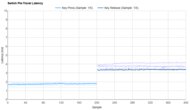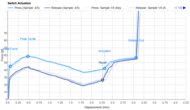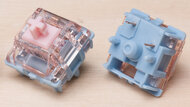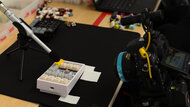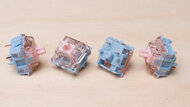Choosing the best keyboard switches boils down to your needs and preferences. There isn't a 'best keyboard switch' for all people and all situations. We've tested over 150 switches and narrowed down ten recommendations for different switch feelings, different price points, and different uses.
If you're new to the hobby and are confused about some of the terms, we'll quickly examine the different kinds of mechanical switches in the FAQ section at the end of the article. Also, note that the pricing of keyboard switches can vary quite a bit depending on the quantity you purchase and the website you buy them from, so it might be worth shopping around a little!
If you're looking for more specific 'best switches' recommendations, see our picks for the best linear switches, the best tactile switches, the best clicky switches, and the best gaming switches.
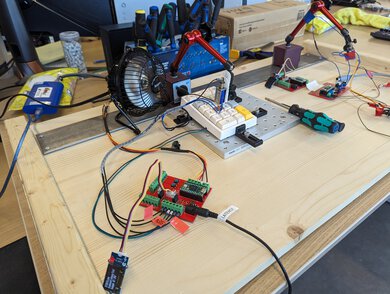
We've tested over a hundred keyboard switches, and to maintain our independence, we buy them all ourselves. We don't just rely on subjective testing. Instead, we rigorously test each switch on the same standardized test bench so you can compare them on equal ground. We use specialized tools, including a Mecmesin force tester for force curves and a Beagle 480 USB analyzer for latency. Multiple teams contribute to each review in a process that can take days or weeks.
-
Best Tactile Switch
 Initial Force:44gfActuation Force:42gfPeak Tactile Force:59gfBottom-Out Force:57gfActuation Distance (Pre-Travel):2.3 mmBottom-Out Distance:3.1 mmSee all our test resultsPin Count:5
Initial Force:44gfActuation Force:42gfPeak Tactile Force:59gfBottom-Out Force:57gfActuation Distance (Pre-Travel):2.3 mmBottom-Out Distance:3.1 mmSee all our test resultsPin Count:5While keyboard switch preferences are hard to pin down for everyone, we recommend Gazzew Boba U4T (62g) switches as the best tactiles for most people. Note that they can be difficult to find in stock with major online retailers, but it's worth checking smaller, specialist distributors like MechMods, RNDKBD, Ringer Keys, or SwagKeys. These switches have minimal pre-travel before ramping into a pronounced and rounded tactile bump that you ride along its long stem throw nearly to the bottom of the keystroke. Typing on these switches is also remarkably stable, thanks to very tight stem tolerances. They come with factory-applied light lubrication, so they're fairly smooth-moving right out of the box. Lastly, and maybe most importantly, these switches have a reputation for producing a deep and satisfying 'thocky' sound that's highly sought after.
Depending on the retailer, you can buy these switches in several different spring weight options. We tested the slightly lighter 62g spring variant, but there are also more medium-weight 65g and 69g variants. Simply put, this all boils down to preference. Lighter springs do a great job of preserving the overall tactility. In contrast, higher spring weights add a bit of cushion towards the bottom of the keypress, which can be a boon for heavier typists to avoid bottoming out too hard.
-
Best Budget Tactile Switch
 Initial Force:44gfActuation Force:39gfPeak Tactile Force:52gfBottom-Out Force:50gfActuation Distance (Pre-Travel):2.1 mmBottom-Out Distance:3.3 mmSee all our test resultsPin Count:5
Initial Force:44gfActuation Force:39gfPeak Tactile Force:52gfBottom-Out Force:50gfActuation Distance (Pre-Travel):2.1 mmBottom-Out Distance:3.3 mmSee all our test resultsPin Count:5For a budget tactile option, we recommend the Akko V3 Cream Blue Pro switches. These are medium-weight tactile switches that introduce a couple of small but impactful improvements over Akko's previous generation Cream Blue switches. These now boast a dustproof stem cover that lends better stability while typing, and they come pre-lubed from the factory, which makes these switches fairly smooth-feeling right out of the box. This makes them a good choice if you're looking for a laid-back build without needing to worry about home lubing.
These switches are also louder and noticeably higher-pitched compared to many tactile options, which typically aim to produce a more resonant sound, like the Gazzew Boba U4T (62g) switches above. If you're interested in taking the time to lube these yourself, you can improve the smoothness slightly and also round out some of the higher-pitched, 'tappy' notes in the sound profile.
-
Best Linear Switch
 Initial Force:41gfActuation Force:54gfPeak Tactile Force:N/ABottom-Out Force:67gfActuation Distance (Pre-Travel):2.4 mmBottom-Out Distance:3.9 mmSee all our test resultsPin Count:5
Initial Force:41gfActuation Force:54gfPeak Tactile Force:N/ABottom-Out Force:67gfActuation Distance (Pre-Travel):2.4 mmBottom-Out Distance:3.9 mmSee all our test resultsPin Count:5The best linear switches we recommend for most people are the Gateron Ink Black V2. These switches are an enduring favorite among custom keyboard enthusiasts, and it's not hard to understand why. Much of what draws people to linear switches is their completely fluid actuation feel, and these switches are some of the smoothest switches you can find right out of the box. They also have a much-admired sound profile that's quite deep and rich but on the quieter side, making these a great option if you're looking to avoid bothering those around you.
The standout weakness these switches are known for is that they tend to be a bit wobbly to type on, despite having a five-pin design, which typically adds stability. Thankfully, you can easily add switch films when building your board, which go a long way in addressing the stability issues and really can elevate this switch's overall typing experience.
-
Best Budget Linear Switch
 Initial Force:44gfActuation Force:46gfPeak Tactile Force:N/ABottom-Out Force:61gfActuation Distance (Pre-Travel):1.7 mmBottom-Out Distance:3.9 mmSee all our test resultsPin Count:3
Initial Force:44gfActuation Force:46gfPeak Tactile Force:N/ABottom-Out Force:61gfActuation Distance (Pre-Travel):1.7 mmBottom-Out Distance:3.9 mmSee all our test resultsPin Count:3For a linear switch at a budget price point, we recommend the Gateron G Pro Yellow switches. Another longstanding favorite in keyboard-building circles, Gateron's Yellow switches come in a dizzying variety of different lineups, families, and versions. You may come across names like Yellow Ink, Yellow Cap V2, KS-8 Yellow, and more. Just know that the differences between all of these models are minor, mostly related to different housing colors or finishes and tiny changes in geometry that tweak typing feel and sound signatures one way or another. That said, they're all built on the same basic characteristics, which include lightweight actuation, great smoothness, and a quiet but deep and pleasant sound profile.
We recommend the G Pro Yellow switches because they're one of the most recent versions made from new molds with tighter tolerances for their stems and housings. Additionally, these switches are pre-lubed from the factory, making them a great no-fuss option that you can drop into your budget build without needing to lubricate them yourself.
-
Best Clicky Switch
 Initial Force:30gfActuation Force:39gfPeak Tactile Force:60gfBottom-Out Force:48gfActuation Distance (Pre-Travel):2.2 mmBottom-Out Distance:3.8 mmSee all our test resultsPin Count:5
Initial Force:30gfActuation Force:39gfPeak Tactile Force:60gfBottom-Out Force:48gfActuation Distance (Pre-Travel):2.2 mmBottom-Out Distance:3.8 mmSee all our test resultsPin Count:5Keyboard switch preferences are highly subjective, but we recommend the Gateron Melodic switches as the best clicky option for most people. True to their name, they make a light and clear-sounding click on the downstroke produced by a delicate mini click leaf integrated into the housing, an uncommon mechanism compared to standard click jacket or click bar designs. They also produce a relatively deep bottom-out sound, which is unusual for clicky switches that are typically higher-pitched.
They're pre-lubed from the factory, too, and the result when you're typing at speed is an extremely smooth, bright-sounding clicking rhythm with a rounded, medium-weight feel. They're great for typing during moderate or extended sessions, but if you prefer a more classic clicky switch with a louder, sharper click and stronger tactile feedback, you may want to consider our next pick instead.
-
Best Budget Clicky Switch
 Initial Force:38gfActuation Force:50gfPeak Tactile Force:57gfBottom-Out Force:54gfActuation Distance (Pre-Travel):1.8 mmBottom-Out Distance:3.6 mmSee all our test resultsPin Count:5
Initial Force:38gfActuation Force:50gfPeak Tactile Force:57gfBottom-Out Force:54gfActuation Distance (Pre-Travel):1.8 mmBottom-Out Distance:3.6 mmSee all our test resultsPin Count:5For a more budget-friendly clicky option, we recommend the Kailh Box White V2 switches. These switches are noticeably lighter-feeling than many clicky switches, including the Kailh Box Jade ones above. They offer crisp actuation with solid tactile feedback, and, like other box design models, they have a dustproof perimeter stem that adds a bit of overall typing stability.
Their typically long spring length also lends a more active and responsive feeling to the return travel. Altogether, these switches are a great choice if you appreciate the clicky sound profile but want to avoid the heavier feel that most clicky switches are known for. They come pre-lubed from the factory, so it isn't necessary to open them up and lube them yourself if you prefer not to.
-
Best Switch For Gaming
 Initial Force:38gfActuation Force:45gfPeak Tactile Force:N/ABottom-Out Force:61gfActuation Distance (Pre-Travel):1.4 mmBottom-Out Distance:3.3 mmSee all our test resultsPin Count:3
Initial Force:38gfActuation Force:45gfPeak Tactile Force:N/ABottom-Out Force:61gfActuation Distance (Pre-Travel):1.4 mmBottom-Out Distance:3.3 mmSee all our test resultsPin Count:3The best gaming switches we recommend for most people are the Cherry MX Speed Silver switches. While much of the enthusiast market has moved away from some of the older Cherry MX models, these switches are an interesting exception. Ultimately, it has a lot to do with their simplicity. They don't come pre-lubed from the factory, but they're some of the fastest and most lightweight-feeling switches available, making them an obvious choice for playing fast-paced or competitive games.
That said, the super-light actuation force of these switches can be a downside if you're a bit on the twitchy side while gaming or if you just like resting your fingertips on your keycaps, as this can easily produce accidental keystrokes. If you're more interested in a tactile option, we recommend checking out Kailh Speed Copper switches. These offer the same high-end latency performance but have a very early tactile bump to overcome.
-
Best Silent Linear Switch
 Initial Force:31gfActuation Force:38gfPeak Tactile Force:N/ABottom-Out Force:45gfActuation Distance (Pre-Travel):2.0 mmBottom-Out Distance:3.4 mmSee all our test resultsPin Count:3
Initial Force:31gfActuation Force:38gfPeak Tactile Force:N/ABottom-Out Force:45gfActuation Distance (Pre-Travel):2.0 mmBottom-Out Distance:3.4 mmSee all our test resultsPin Count:3We recommend TTC Frozen Silent V2 switches as the best quiet linear option available. They're lightweight and deliver a surprisingly premium typing experience despite their more budget price point. Their design utilizes a lengthened spring, which provides the return stroke with a more active feel, making them feel fast and responsive for quick typists. As expected, they're whisper-quiet thanks to a silicone ring that dampens noise at the top of travel and a small silicone pad at the bottom that effectively mutes keystrokes without adding the mushiness common to cheaper silent switches.
They also come with consistent factory lubrication, so there's no need to lubricate them yourself. Their clear top housings allow RGB lighting to shine through cleanly without noticeable diffusion or color bleed. All their qualities together make them one of the most enduringly popular choices among enthusiasts looking to minimize typing noise without sacrificing typing feel.
-
Best Silent Tactile Switch
 Initial Force:64gfActuation Force:41gfPeak Tactile Force:67gfBottom-Out Force:67gfActuation Distance (Pre-Travel):2.1 mmBottom-Out Distance:3.3 mmSee all our test resultsPin Count:5
Initial Force:64gfActuation Force:41gfPeak Tactile Force:67gfBottom-Out Force:67gfActuation Distance (Pre-Travel):2.1 mmBottom-Out Distance:3.3 mmSee all our test resultsPin Count:5If you love the feel of tactile switches but want to keep noise to an absolute minimum, Durock T1 Silent Shrimp switches are the best quiet tactile option we recommend for most people. Making a tactile switch quiet without dulling its feedback is a genuine engineering challenge since the parts that dampen sound can also soften the tactile bump. The latest generation of silent tactiles has significantly improved over older designs, offering impressively low noise levels while retaining the distinct tactility that defines this switch type. That said, even the best silent tactiles still produce slightly more noise than linear options, such as the TTC Frozen Silent V2 mentioned above.
Durock T1 Silent Shrimp switches have a medium-weight bump that engages early in the press, giving each keystroke a crisp, well-defined feel. The downstroke lands softly and quietly without feeling squishy, avoiding the overly dampened sensation common in older designs. These switches ship with consistent factory lube that helps them feel smooth right out of the box, though enthusiasts often find that hand-lubing can make them feel even more uniform and refined. Their translucent turquoise housings diffuse RGB lighting evenly and allow a good amount of light to escape, which is great for RGB-forward builds, although the tint can slightly cool the color of your lighting.
-
Best RGB-Friendly Switch
 Initial Force:47gfActuation Force:53gfPeak Tactile Force:N/ABottom-Out Force:68gfActuation Distance (Pre-Travel):1.7 mmBottom-Out Distance:3.7 mmSee all our test resultsPin Count:5
Initial Force:47gfActuation Force:53gfPeak Tactile Force:N/ABottom-Out Force:68gfActuation Distance (Pre-Travel):1.7 mmBottom-Out Distance:3.7 mmSee all our test resultsPin Count:5If you want to showcase your board's RGB lighting to the fullest extent, we recommend the Gateron North Pole 2.0 Yellow switches. Note that all switches on this list will work with your RGB to some degree; however, the more transparent a switch is, the more this effect is amplified. The Gateron North Pole 2.0 Yellows are based on the Gateron Yellow switches, which are an all-around community favorite, but what sets this variant apart is that the upper and lower housing (and even the switch stems) are made of clear polycarbonate plastic, which does a much better job of letting RGB light bounce around and expand out from the switch compared to switches made of darker or opaque material.
As a final note, these switches are a follow-up to Gateron's original North Pole 1.0 Yellow switches. While the fundamentals remain the same, the 2.0 switches feature a small, yellow-colored silicone disk at the base of the stem. This addition softens the bottom-out sensation somewhat, but it also significantly alters the sound profile. If you prefer a deeper, 'thockier' sound, you'll prefer the North Pole 1.0 switches better, as they don't have this piece. Alternatively, the Gateron North Pole 2.0 switches have a much quieter, muted sound, almost like a silent switch.
Recent Updates
Nov 05, 2025:
We’ve added Gateron Melodic switches as our new 'Best Clicky' pick. We’ve also introduced two new categories: 'Best Silent Linear,' featuring TTC Frozen Silent V2 switches, and 'Best Silent Tactile,' featuring Durock T1 Silent Shrimp switches as our pick.
Apr 28, 2025:
We've reviewed current pricing and aren't making any changes to our picks at the moment. However, we're keeping a close eye as trade conditions evolve. If you notice unusual price or availability issues, we encourage you to let us know so we can keep this guide as accurate and helpful as possible.
Jan 24, 2025:
We've reviewed our recommendations to ensure their relevance, pricing, and availability remain up to date, but our lineup remains unchanged.
Oct 29, 2024:
We've reviewed all our recommendations and verified their ongoing price and availability. We haven't made any changes to our lineup with this update.
Aug 06, 2024: We've updated some of the links to smaller distributors in this article for the best current stock availability, but we aren't making any changes to our recommendations with this update.
FAQ
We've tested over 150 mechanical switches. The sheer number of switches available and the small differences between them may be intimidating, but their designs are surprisingly similar. To simplify, mechanical switches fall into three categories:
Linear
These switches are smooth all the way down. While they don't offer any tactile feedback during your keystroke, they make up for it in speed. While some typists prefer linear switches for their fluid, consistent feel and quiet operation, some may find them too sensitive, making you more prone to make mistakes while typing.
Linear switches are also a popular choice for gamers who look to linear switches for their lightness and short pre-travel distances to register keystrokes as fast as possible.
Tactile
The middle option between linear and clicky, a tactile switch, has a tactile 'bump' that you overcome when pressing a key. This bump provides physical feedback near the actuation point, letting you know when you've registered a keystroke. Many typists prefer tactile switches because the tactile bump indicates when a key has been registered, helping to minimize typos. Additionally, tactile switches are generally not loud enough to be a disruption to those around you, even in open office environments.
Like linear switches, some tactile switches feel lighter or heavier and have different pre-travel and total travel distances. Additionally, different models will have tactile bumps that appear earlier or later in the keystroke.
Clicky
True to their name, these switches make clicky sounds. Clicky switches are also known for being loud and often somewhat heavier-feeling than other switches. Some are quieter than others, but generally speaking, they can be disruptive in closed environments, and some workplaces even have policies against using them in open office settings.
Functionally, they're just like tactile switches but have an additional internal mechanism that produces an audible click during the keypress. This mechanism is a little different depending on the clicky switch in question, and some make a clicky sound on both the downstroke and upstroke.
All Reviews
Our recommendations above are what we think are currently the best switches for keyboard enthusiasts. While no switch is perfect for every person and every use, most will perform adequately in any role.
When choosing our recommendations, we factor in the price, feedback from our visitors, and availability. If you'd like to do the work of choosing yourself, here's the list of all the keyboard switches we've tested below.



